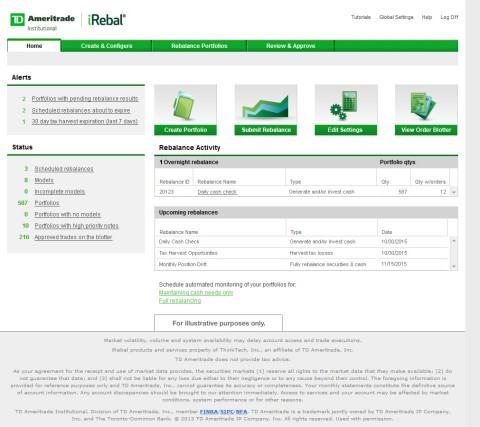How To Explain Portfolio Rebalancing To Clients
Post on: 3 Июнь, 2015 No Comment

Rebalancing is the action of bringing a portfolio that has deviated away from one’s target asset allocation back into line. The objective is to maintain a consistent mix of asset classes (most commonly equities vs. fixed income ) in order to control risk at the level desired by the investor. This is accomplished by transferring funds from higher-performing classes to lower-performing classes. While potentially counterintuitive, rebalancing ensures that investors Buy Low and Sell High.
Contents
Example
- You own two funds (Fund A and Fund B)
- You have a $10,000 portfolio and have selected an asset allocation such that each fund represents 50% of the total ($5000 each)
- Over time, Fund A rises in value to $6000 while Fund B declines in value to $4000 — you now have a 60/40 split instead of 50/50
- To maintain your asset allocation, you would rebalance your portfolio by taking $1000 from Fund A and transferring it to Fund B
- After doing so, your asset allocation is once again 50/50
Different rebalancing approaches
There are a variety of ways in which investors determine it is time to rebalance:
- When asset classes deviate from their target by a certain absolute percentage. For example, if your target asset allocation is 60% equities and 40% fixed income and your rebalancing threshold is +/- 5%, you would rebalance your portfolio when your portfolio reaches (65% equities / 35% fixed income) or (55% equities / 45% fixed income). [note 1]
- When an investment in an asset class deviates from its target by a certain relative percentage. typically 25%. For example, if your target equities asset allocation is 60%, composed of 40% Total Stock Market and 20% Total International, you would rebalance International if it changes by more than +/- 5% (25% of 20%). [note 1]
- When asset classes deviate from their target by a certain dollar amount. For example, if you hold $6000 in equities and $4000 in fixed income and your rebalancing threshold is +/- $1000, you would rebalance your portfolio when either of your holdings deviates from their target asset allocation of 60% equities / 40% fixed income by at least $1000.
- When contributing to or withdrawing from your portfolio. For example, if your target allocation is 60% equities and 40% fixed income, you hold $7000 of equities and $3000 of fixed income, and you wish to contribute $1000 to your portfolio, you would simply buy $1000 worth of fixed income assets. This would bring you to an allocation of 64% equities / 36% fixed income. This approach minimizes transaction costs, effort, and taxes. This portfolio rebalancing calculator can help in cases where it isn’t obvious how much of a new contribution or withdrawal to allocate to each asset.
Other considerations
- Transaction costs should be noted when deciding whether or not to rebalance. Since many transactions have costs associated with them, many investors choose to wait for their portfolio to pass a significant threshold of deviation (whether defined by percentage or dollars) before rebalancing
- Many investors find it difficult selling winners to buy losers. To help remove emotions from the decision, many choose a specific date to rebalance (e.g. Birthday, Tax Day, etc.). Note: Investors who find the prospect daunting may want to consider Target Retirement Funds. which automatically rebalance as necessary to maintain a consistent asset allocation.
Estimating changes in asset allocation
- Shifting the balance of a 50/50 portfolio by 1% requires a 4% change in the price of stocks relative to bonds. All other portfolios are less sensitive, with 70/30 or 30/70 requiring a 5% change, 80/20 or 20/80 a 6% change, and 90/10 or 10/90 an 11% change. For example, a $10,000 60/40 portfolio will, after a 10% stock market drop, have $6,000 * 0.9 = $5,400 in stocks and $4,000 in bonds, for a stock allocation of $5,400 / ($5,400 + $4,000) = 57.45%, a 2.55% shift.














